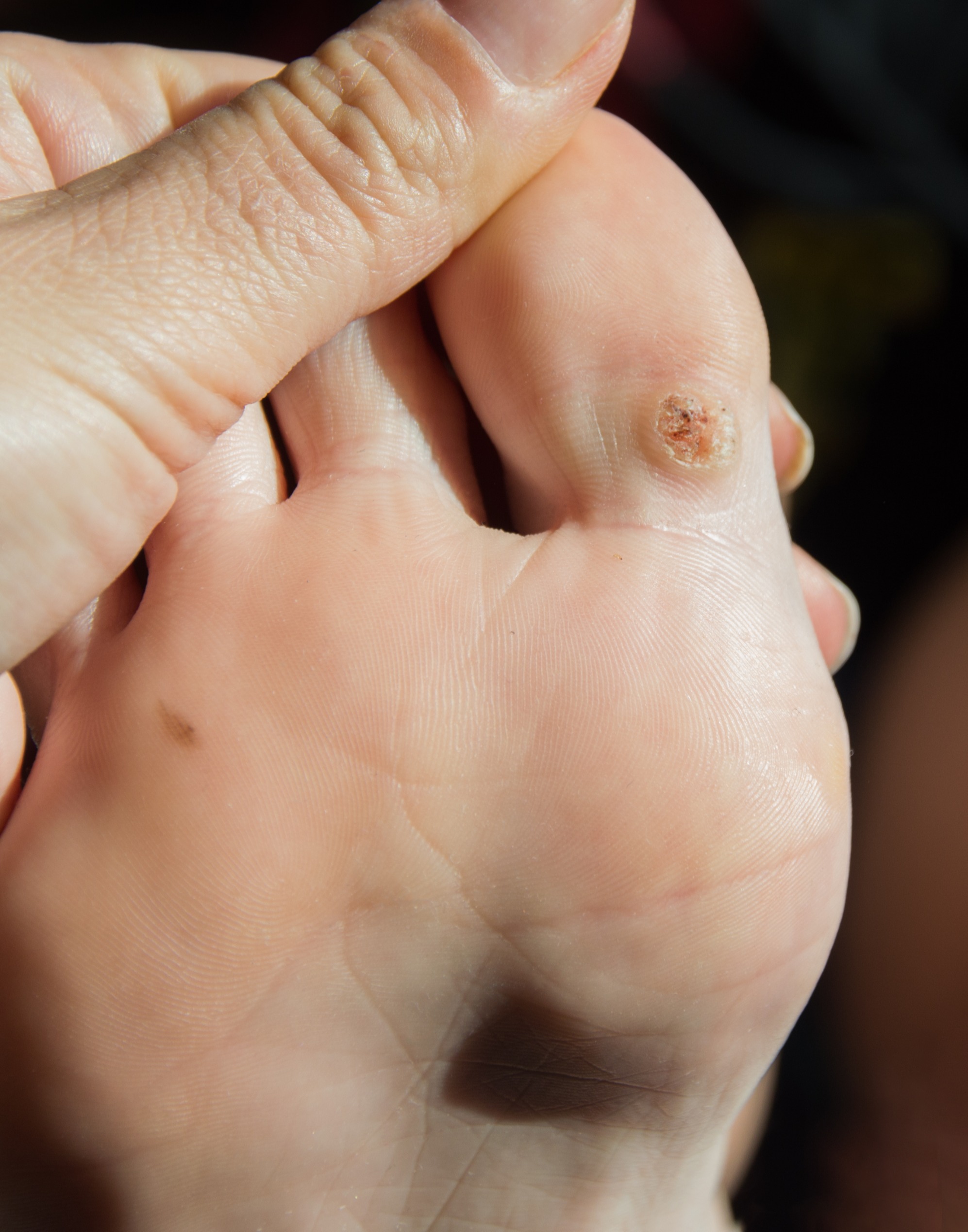- Home
- >
- WART Surgery in Perth



Warts are caused by infection with a type of human papillomavirus (HPV). HPV types 1,2,3 and 4 commonly affect the foot. Factors that increase the risk include use of public showers, working with meat, eczema and a weak immune system. The virus is believed to enter the body through skin that has been damaged slightly. Over time, the wart develops into a hard, rough growth on the surface of the skin. A wart is most commonly seen on the bottom of the foot (known as a plantar wart or verruca plantaris) but can also appear on the top. Children, teens, and people with allergies or weakened immune systems are more vulnerable to the wart virus.
Warts may appear spongy, with tiny red, brown, or black spots. They can grow up to an inch or more across, occurring alone (solitary) or with smaller warts clustered nearby (mosaic). Warts are sometimes mistaken for corns or calluses. They can persist for years and recur in the same spot. If left untreated, warts can spread to other parts of the foot or even to the hands or other areas of the body.
The most important treatment is to know you are treating a wart and not a corn or callus. Our Podiatrists can examine your wart carefully to determine that it is not a corn or a callus. A wart will usually feel painful when a podiatrist squeezes it from side to side. To examine the wart further, the hard skin layer around it may need to be trimmed by our podiatrists. A wart will have certain spots that bleed when trimmed; a callus will not.
As yet, there is no single totally effective treatment for viral warts. Some patients may choose to leave their warts untreated until spontaneous resolution which may take up to many years. There are many ways to treat verrucae (warts), depending on their size and location. Medications, cryotherapy, needling, surgical removal (curettage), or a combination, may be effective treatments to remove warts. Please read below for more detailed information regarding all of the treatment options.
The most common is an acid paste or liquid medication to burn the wart followed by regular debridement of the wart by one of our podiatrists. The most common acid is salicylic acid or home acid treatments such as Duofilm. The use of Duofilm in a specific way we tend to find the easiest to apply and gives the best results. This is the first line of conservative treatment we generally recommend.
Another option that we find works well with paediatric patients is the use of Cantharidin. The
Cantharidin other wise known as “Beetle Juice” is very successful in paediatrics who are afraid of needles. The procedure involves shaving of the wart to pin point bleeding and applying a small smear of Cantharidin over the affected area. This is absolutely painless and does not require any anaesthetics. In 2-3 days the area blisters and you will be instructed how to manage the blister. The proceduremay be repeated 2-3 times or until the wart disappears.
Cryosurgery is the application of extremely low temperatures to freeze the wart. Your wart will be paired and liquid nitrogen is applied to the lesion. This may cause blistering which can get rid of the wart. You may need an average 2-3 treatments to get of the wart. The success rate is approximately 60-70%.
The wart borders are defined and then sharply excised (under local anaesthetic) using a small, spoon shaped instrument called a curette. When performing curettage care is taken not to go deeper than the epidermal/dermal layer to reduce the chance of scarring. This is so important as scarring to the sole of your feet can potentially cause long term painful corns or callouses which can be even worse in terms of pain than your original wart.
To lessen the pain of the procedure, a local anaesthetic is used with this surgical procedure. Please be assured that if you are at all anxious with the procedure or have a needle phobia, we can administer Penthrox inhaler (known as ‘Green Whistle’ – image below). Dr Reza Naraghi being a podiatric surgeon can also issue oral sedation medication to help with local anaesthetic injections. Alternatively, the procedure can be done under general anaesthesia at one of our affiliated hospitals and surgery centres.
If you are planning to have the curettage option depending on the location of the wart your foot will be anaesthetized at the level of the ankle. Your foot will be numb for few hours after the procedure. After the excision of the wart phenol solution will be applied to the base of the wart which in our experience has significantly increased the success rate in eradicating the wart.
You will need to arrange for transportation to and from our rooms on the day of surgery. Depending on the location of the wart you may be asked not to drive and be off your foot for 2-3 weeks until the area has healed. The use of crutches may be needed.
In our experience wart curettage has higher success rate than other modalities to eradicate warts. However, there is always a chance for the resistant warts to return especially when you are on immunosuppressive drugs and have diminished immune system.
This treatment allows an immune system response to stimulate the body to fight and remove the wart virus. This may need to be performed 2 to 3 times to see results. The benefits of this procedure is that you can immediately weight bear. Please refer to Dr Naraghi’s research paper in Journal of American Podiatric Medical Association where needling versus liquid nitrogen cryotherapy for the Treatment of Pedal Warts was researched.
Dinitrochlorobenzene
DNCB (dintrochlorobenzene) is a synthetic compound that treats warts by stimulating your body’s immune system. This agent can be used to make your immune system attack the warts once your immune system’s cells have been taught to recognize DNCB as a foreign compound. This compound needs to be prescribed by your GP. From our experience we have not seen much success with this option.
Laser
The wart is vaporized, using focused light energy produced by a laser. To lessen pain, a local anaesthetic is often used with this procedure.
What Can I Do About Warts?
After your podiatrist treats your warts, protect your feet from future infection by keeping them clean and dry. If you’re thinking of using over-the-counter medications for warts, ask your podiatrist first. Some of these treatments can damage skin – and may be dangerous if you have diabetes or poor circulation.
Avoid going barefoot in public places like showers, gyms, and locker rooms. The wart virus may spread easily in settings like these, so it is recommended to wear thongs or sandals on your feet.


Designation

Designation
